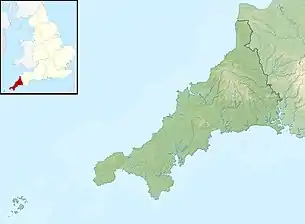St Agnes Lifeboat Station, Isles of Scilly
St Agnes' Lifeboat Station was situated in St Agnes, Isles of Scilly and provided a service for the Royal National Lifeboat Institution from 1891 to 1920. The lifeboat station and slipway still exist, and have been identified by the Isles of Scilly Council as a Building of Local Significance.[1]
| St Agnes's Lifeboat Station, Isles of Scilly | |
|---|---|
 Former St Agnes’ lifeboat station and slipway | |
 Isles of Scilly | |
| General information | |
| Type | RNLI Lifeboat Station |
| Location | St Agnes Lifeboat Station, St Agnes, Isles of Scilly, UK |
| Country | UK |
| Coordinates | 49°53′37.09″N 6°21′00.06″W |
| Opened | 1890 |
| Owner | Royal National Lifeboat Institution |
Lifeboats at St Agnes
| Dates in service | Class | ON | Op. No. | Name | Comments |
|---|---|---|---|---|---|
| 1891–1904 | James and Caroline | ||||
| 1904–1909 | Liverpool Type | Charles Deere James | Built by the Thames Ironworks and Shipbuilding Company. 38 feet (12 m) long. 10 feet (3.0 m) broad. She rowed 10 oars and was fitted with two drop keels and two water ballast tanks[2] | ||
| 1909–1920 | Watson Type | Charles Deere James (II) | Built by the Thames Ironworks and Shipbuilding Company. 38 feet (12 m) long. 9.33 feet (2.84 m) broad. She rowed 10 oars and was fitted with a drop keel[3] |
History
The station opened in 1891 with a single slipway. A new slipway was provided in 1904 at a cost of £5,000 (equivalent to £543,000 in 2019)[4] to the designs of the Institution’s Architect, W.T. Douglass. From the back of the boat house to the toe of the slip it was 1,068 feet (326 m). It was built of Jarrah wood from Western Australia, bolted to granite and concrete pillars, with the exception of a short piece at the upper end, built on the rocks. Two rails ran the entire length of the slip, on which rested the double bogey trolley that carried the boat. Rails were also laid down the old slip which could be used at high tide.[5]
Awards

On 13 December 1907, the Thomas W Lawson of Boston, USA, was in distress off Annet. The St Agnes Lifeboat put William Thomas Hicks on board to act as pilot. But the schooner foundered at Minmanueth and he was lost together with fifteen of the vessel’s crew. His son, Frederick Charles Hicks, put off with seven other men in the gig ‘Slippen’ which rescued the schooner’s captain and engineer form Hellweather rock.
Frederick Charles Hicks was awarded the RNLI Silver Medal for bravery, when swimming from a gig to save the captain of the Thomas W Lawson. The United States government gave him a gold watch, and gold medals to all the crewe of the gig ‘Slippen’.
References
- "Isles of Scilly Conservation Area Character Statement Supplementary Planning Document" (PDF). Isles of Scilly Council. Isles of Scilly Council. 8 June 2015. Retrieved 28 September 2015.
- "New Lifeboat for Scilly". Cornishman. Truro. 4 August 1904. Retrieved 28 September 2015 – via British Newspaper Archive.
- "New Lifeboat for Scilly". Cornishman. Truro. 29 July 1909. Retrieved 28 September 2015 – via British Newspaper Archive.
- UK Retail Price Index inflation figures are based on data from Clark, Gregory (2017). "The Annual RPI and Average Earnings for Britain, 1209 to Present (New Series)". MeasuringWorth. Retrieved 2 February 2020.
- "Launch of the St Agnes Lifeboat". Cornishman. Truro. 25 August 1904. Retrieved 28 September 2015 – via British Newspaper Archive.
